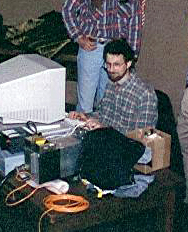David L. Rabinowitz

David Lincoln Rabinowitz (born 1960) is a researcher at Yale University. He has built CCD cameras and software for the detection of near-Earth asteroids and Kuiper Belt Objects,[1] and his research has helped reduce the assumed number of near-Earth asteroids by half, from 1,000-2,000 to 500-1,000[2] He has also assisted in the detection of distant solar system objects, supernovae, and quasars, thereby helping to understand the origin and evolution of the solar system and the dark energy driving the accelerated expansion of the universe.
Collaborating with Michael E. Brown and Chad Trujillo of the Quasar Equatorial Survey Team, he has participated in the discovery of several TNOs, among them:
- 90377 Sedna - possibly the first known inner Oort cloud object.[3]
- 90482 Orcus[4]
- Eris - a dwarf planet larger than Pluto.[5]
- Haumea[6]
- Makemake[7]
although he would not get credit for Haumea.
Together with Tom Gehrels of the University of Arizona and his Spacewatch Team, Rabinowitz co-discovered one other astronomical object:
Notes
- ^ David Rabinowitz overview
- ^ Nasa report on the reduction of the number of near earth asteroids.
- ^ The Astrophysical Journal.
- ^ BBC report.
- ^ M. E. Brown, C. A. Trujillo, D. L. Rabinowitz (2005). "Discovery of a Planetary-sized Object in the Scattered Kuiper Belt". The Astrophysical Journal 635 (1): L97-L100. DOI:10.1086/499336.
- ^ M. E. Brown, A. H. Bouchez, D. L. Rabinowitz, R. Sari, C. A. Trujillo, M. A. van Dam, R. Campbell, J. Chin, S. Hartman, E. Johansson, R. Lafon, D. LeMignant, P. Stomski, D. Summers, P. L. Wizinowich Keck Observatory laser guide star adaptive optics discovery and characterization of a satellite to large Kuiper belt object 2003 EL61, The Astrophysical Journal Letters, 632, L45 (October 2005) Full text from Caltech
- ^ Memphis Archeological and Geological Society.
- ^ The Encyclopedia of Astrobiology, Astronomy and Spaceflight.
